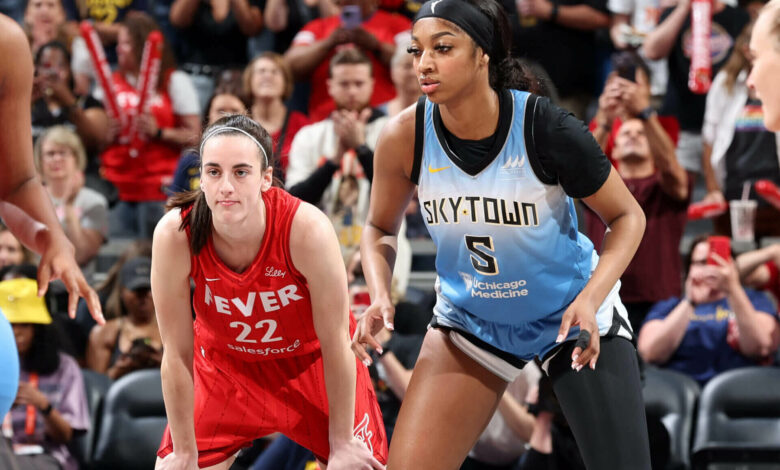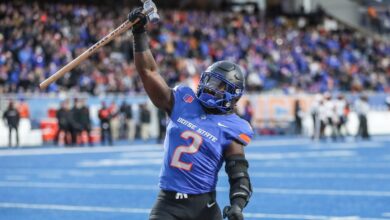Caitlin Clark and Angel Reese should share the ROY award, just as they get a place in WNBA history

Late next week, the WNBA will send out ballots for its end-of-season awards. Sixty-eight media members will have eight days to submit selections for 10 different awards, including Most Valuable Player, Defensive Player of the Year and first- and second-team All-WNBA.
What I’m about to say will never happen, and I know it would be incredibly unpopular on the fringes of Caitlin Clark and Angel Reese fandom, where rational discussion dies and a compliment from one player is seen as a criticism of the other. But who cares. Let’s do it anyway.
For me, this season’s Rookie of the Year award should be shared between Clark and Reese, not just for their accomplishments on the court, where they’ve both done things never before seen in the league’s nearly three-decade history, but for their impact off it. The two have been like neodymium magnets, drawing viewers and generating revenue at a dizzying rate.
Longtime followers of the league will argue that the W’s popularity was already growing before the rookies arrived, which is true. But interest among mainstream media and casual fans was negligible for much of that time. Broadcast partners even treated the W as an afterthought, without promoting or amplifying it with much vigor.
Today, however, the league has a permanent spot on ESPN’s roster, and its stars are sought-after guests on popular podcasts. Is that just because of Clark and Reese? No. But is it largely because of them? Yes.
Their Q Scores coming out of college were as high or higher than anyone else in the W, the byproduct of a rivalry that began two seasons ago when Reese and LSU defeated Clark and Iowa for the NCAA championship. Moving on to the W, the two took all those eyes with them, boosting the league’s popularity to a point not seen since its inaugural season.
Their impact is evident in the attendance figures. Clark, the all-time leading scorer in NCAA history, has helped the Indiana Fever go from 11th among 12 teams in average attendance in 2023, with 4,066, to first place with 16,978. according to Across the TimelineIt’s no surprise that the Fever were the opponent in July when the two-time reigning champion Las Vegas Aces drew 20,366 fans to T-Mobile Arena, the largest WNBA crowd in 25 years.

Free daily sports updates straight to your inbox.
Free daily sports updates straight to your inbox.
That Indiana is also the most popular away team should come as no surprise to anyone — the Fever draws an average of 14,837 away fans, according to Across the Timeline — but it might come as a surprise to casual viewers that the struggling Chicago Sky is No. 2. The main reason? They’re led by Reese and her 4.1 million Instagram followers.
That’s why I think they should share the award. Years from now, when pieces are written about the growth of the league, all roads will likely lead back to 2024 and the arrival of Clark and Reese. What better way to acknowledge that than by putting their names next to each other in the record books?
I don’t care what comparisons you make @Reese10Angel And @CaitlinClark22 deserve the Rookie of the Year Award! The pressure and weight of this season has taken its toll on @WNBA and both rookies reached the top and exceeded all our expectations! Take a bow ladies👏🏽👏🏽
— Lisa Leslie (@LisaLeslie) September 2, 2024
I can see why some would rather limit the vote to on-court performance. If I were forced, my vote, if I had one, would go to Clark. Her ability to impact games as a shooter, passer, and pacer is remarkable, and she will only get better. Plus, she’s helped make the Fever relevant for the first time in years, taking them from a 3-10 start to a team that could be a playoff problem.
Indiana has won four in a row, six of seven, and is 9-3 as of July 6. In that span, the Fever have defeated four of the top five teams in the rankings — New York, Connecticut, Seattle and Minnesota — as well as a dangerous Dallas squad. At 17-16, they have clinched a playoff spot for the first time since 2016, are above .500 for the first time in more than five years and have scored 100 or more points in back-to-back games for the first time in franchise history. That means something.
Individually, Clark has broken the franchise’s rookie scoring record, the W’s single-game assists record (19 vs. Dallas) and is on pace to break the league’s single-season assists record. She currently leads the league with an average of 8.4 assists per game. Even more telling, she has scored or assisted on 37.3 percent of the Fever’s points, according to ESPNwhich would break the WNBA record if it were to remain.
Reese’s game isn’t as diverse or polished, but that doesn’t make it any less dominant. When you’re breaking league records — not just rookie records — once held by legends like Candace Parker, Sylvia Fowles and Tina Charles, you’re in rarefied air, which is the case for Reese. The “Bayou Barbie,” as she’s been called, is a relentless window washer who holds league records for total rebounds and offensive rebounds. She’s also a walking double-double whose 15 consecutive games with double figures in points and rebounds broke Parker’s record. She currently has 25 double-doubles, which is three shy of the league record set by Alyssa Thomas in 2023.

GALLING DEEPER
Angel Reese sets WNBA record for rebounds in a single season
But talking about Reese or Clark in terms of statistics alone seems insufficient given their importance to the league. Some have tried to compare their arrivals to that of Magic Johnson and Larry Bird in the NBA in 1979. While they were similar in some ways — they were rivals competing in an NCAA finals; one was black, the other white — there was a subtle but significant difference. Johnson and Bird helped revive a moribund league, while Clark and Reese built on a foundation that was already there, which is no small feat. The feat is even more impressive when you consider the growth of the league.
Consider this: The W tracks the demographics of its audience and what it calls complementary viewing figures (CVM) among diversified groups. In the first month of the season, its CVM grew 60 percent year over year among people of color. The most represented demographic groups in that category — Hispanics and African Americans — saw ratings increase 96 percent and 67 percent year over year, respectively, according to the competition.
“The growth of diverse audiences is also resulting in deeper and more frequent single-user engagement across digital platforms,” the league said in a statement at the time. “WNBA App monthly active users are up 613 percent year-over-year, and League Pass subscriptions more than tripled through the first two weeks of the season with the highest average minutes watched in league history.”
I would argue that these numbers are greater than any player statistic, and therefore Clark and Reese should share the award.
(Photo of Caitlin Clark, left, and Angel Reese: Jeff Haynes/NBAE via Getty Images)




